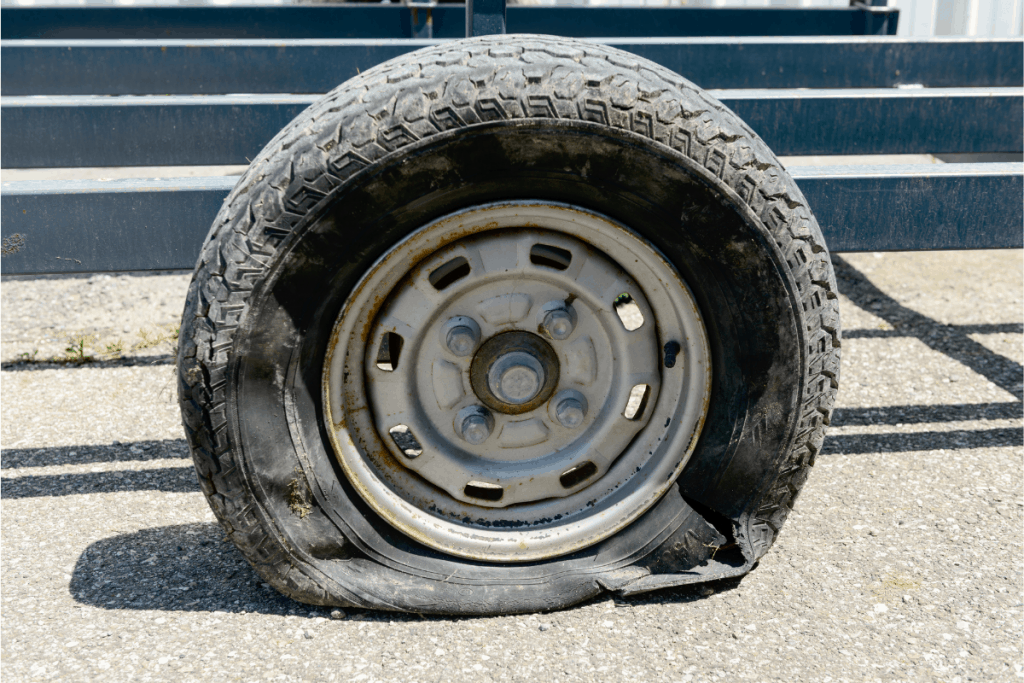
5 Ways To Keep Your Camper Tires From Getting Damaged
Camper tires can be expensive and no fun to change. Here are 5 ways to keep your camper tires from getting damaged and keep you on the road.
1. Proper tire specifications
This one is the most important and often the most overlooked. Every tire is designed to run within certain specifications and knowing these specifications is key.
The first step is making sure you have the proper size and load range tires for your camper. Your camper will likely have the tire specifications listed alongside the weight and load specifications.
If not, the manufacturer or a tire shop will be able to provide you with this information. When buying camper tires it can be tempting to try to save money but investing in quality tires from reputable manufacturers will save you money in the long run.
2. Check tire pressure
Just because tires are new doesn’t mean they are less susceptible to damage. Proper air pressure is essential to the life of camper tires. On travel days, checking air pressure before heading out is a must.
Traveling with improper tire pressure can lead to many issues including tire heat build-up, poor handling, uneven wear, and poor ride. Tire pressure monitoring systems are a popular way to continuously check tire pressure from within your rig while traveling. If you don’t have a monitoring system, then stopping a few times a day for a quick check is cheap insurance and can save you a blowout.
3. Safe storage
We often overlook our camper tires when the season ends and we store them for the offseason. RV storage can be very hard on camper tires as they can sit for long periods of time often in cold climates. Some people choose to remove their tires for storage to prevent having weight on them while not in use.
A tire storage rack is a great way to keep stored tires out of the way. If you have the option of indoor and ideally heated storage, this is of course the best option. Ensuring proper air pressure before storing and doing periodic checks to make sure your tires are not going flat is a good idea.
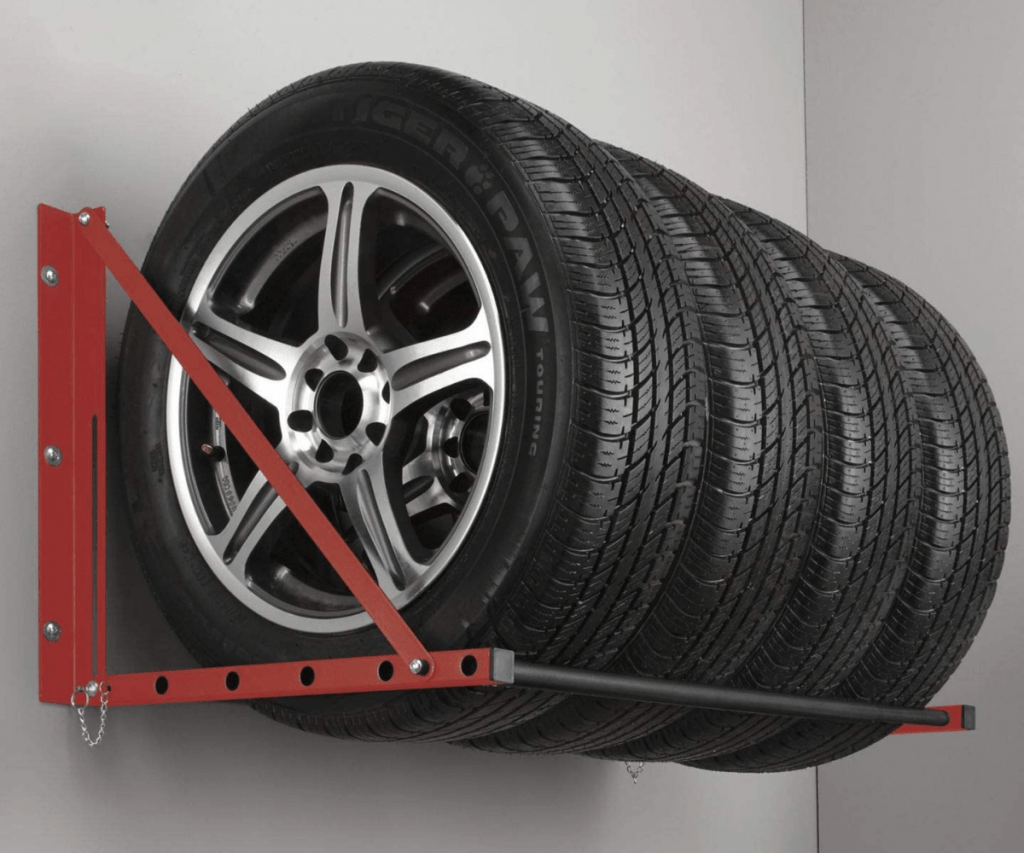
4. Avoid direct sun
The sun is very hard on tires. Just like our skin, tires need protection from direct exposure to the sun. The rubber compounds in tires can dry out and crack after being exposed to the sun. The black color of the tires doesn’t help with attracting the sun.
There are a few options to help limit sun exposure. Tire covers are the most popular way to block the sun from your tires. There are many DIY options, however, tire covers are inexpensive to buy.
There are also products available to help prevent tires from drying out that come in spray-on applications. Many have UV blockers in them; think of it as sunscreen for your tires. Another free option is to choose your parking and camping spots so that your camper is positioned in the shade or so that it gets limited sun throughout the day.
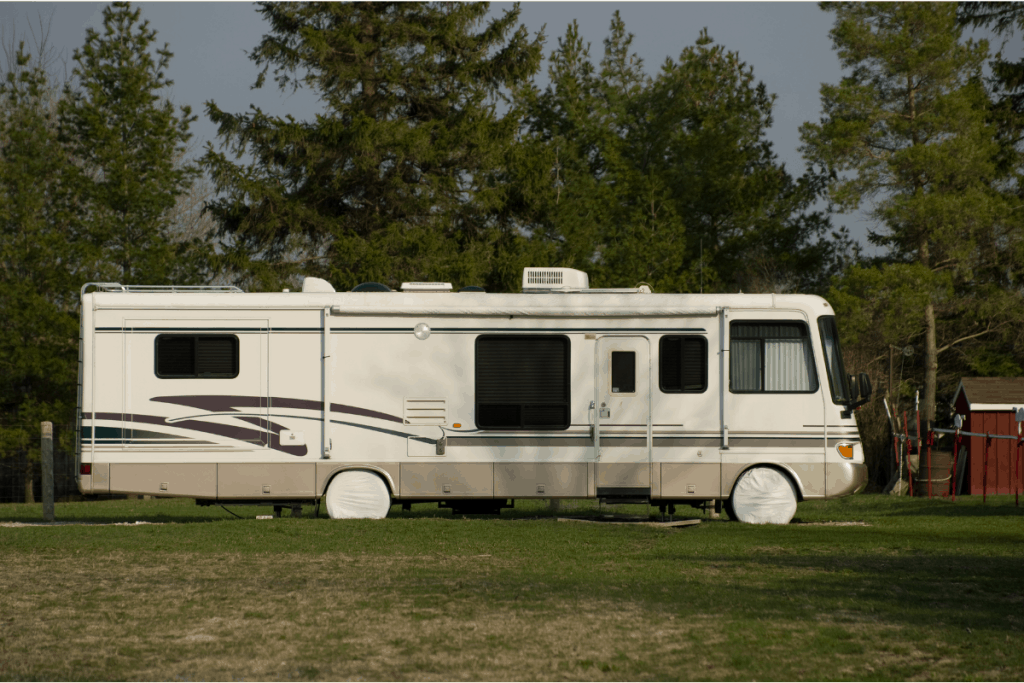
5. Practice defensive driving
Many times, camper tire damage is the fault of the driver. Whether you have a small camper van or a 40-foot fifth-wheel, there are challenges that come with driving a camper.
In the case of large RVs, curbs are the result of many damaged tires due to the space required to make turns. Often times you are traveling to remote areas with rough terrain. Even at campgrounds there are many obstacles to navigate like rocks and stumps.
Doing a walk around of the area you are entering is an easy way to avoid possible damage. Another way is to have a spotter guide you. When underway during travel, be alert and drive with care. Give yourself enough time and space to avoid potholes, road debris, and navigate turns. Consider a rearview camera to help avoid damages.
Camper tires are the connection between your camper and the road and so it is vital that you keep them in good condition. Proper care will ensure you get the maximum life out of your tires and will lessen your chances of having a blowout or flat. Make sure you keep track of all your RV tire maintenance with an online tool such as RV LIFE Maintenance.
Continue reading:


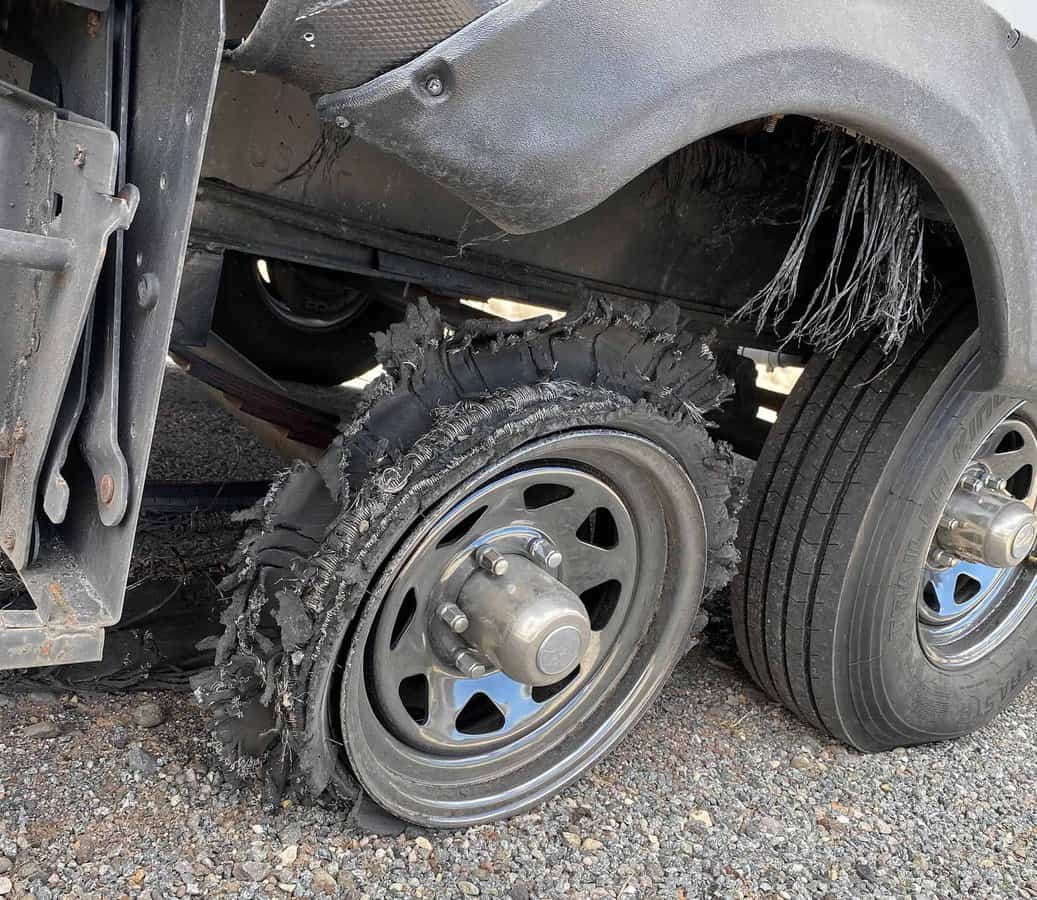
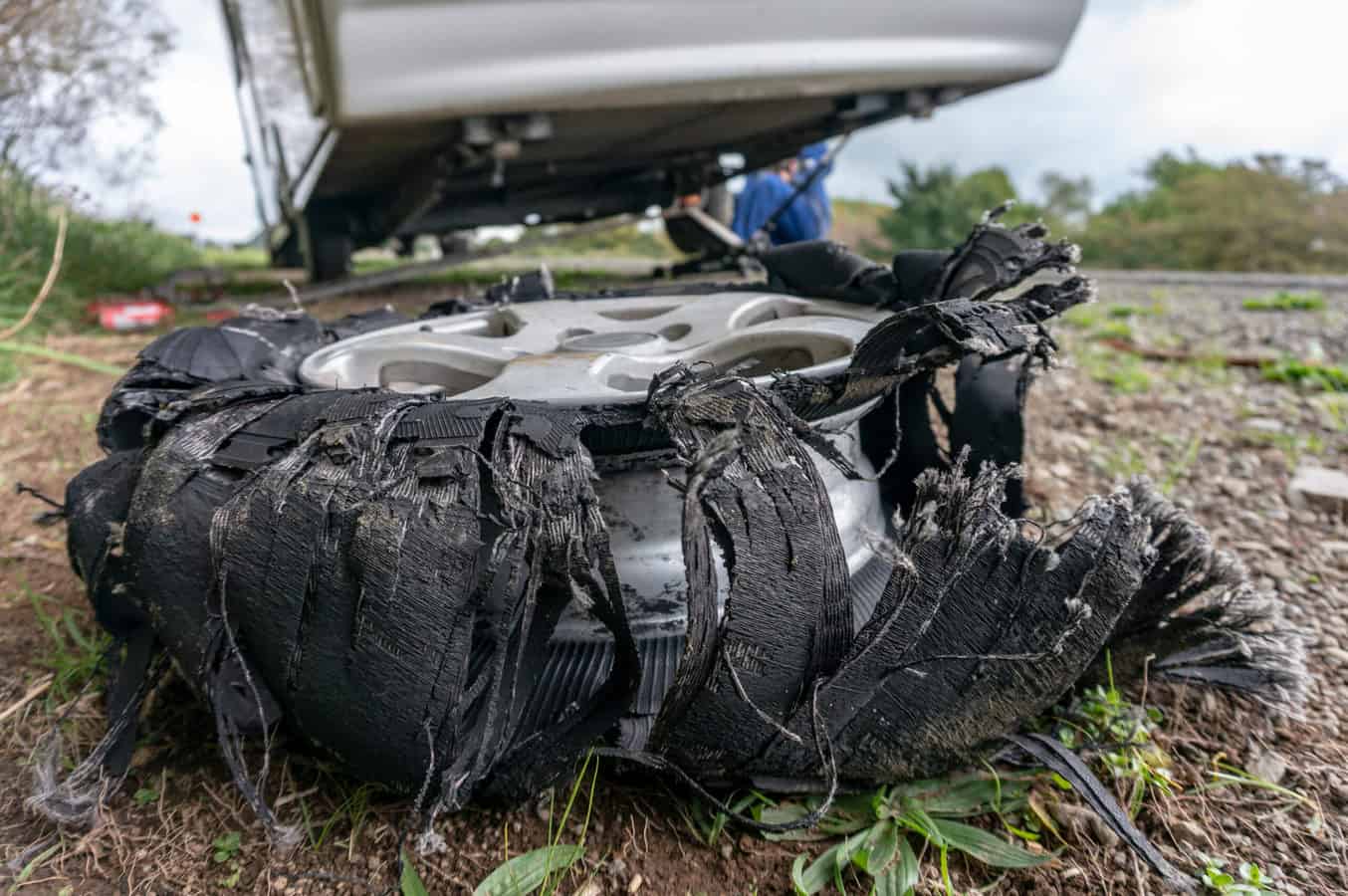
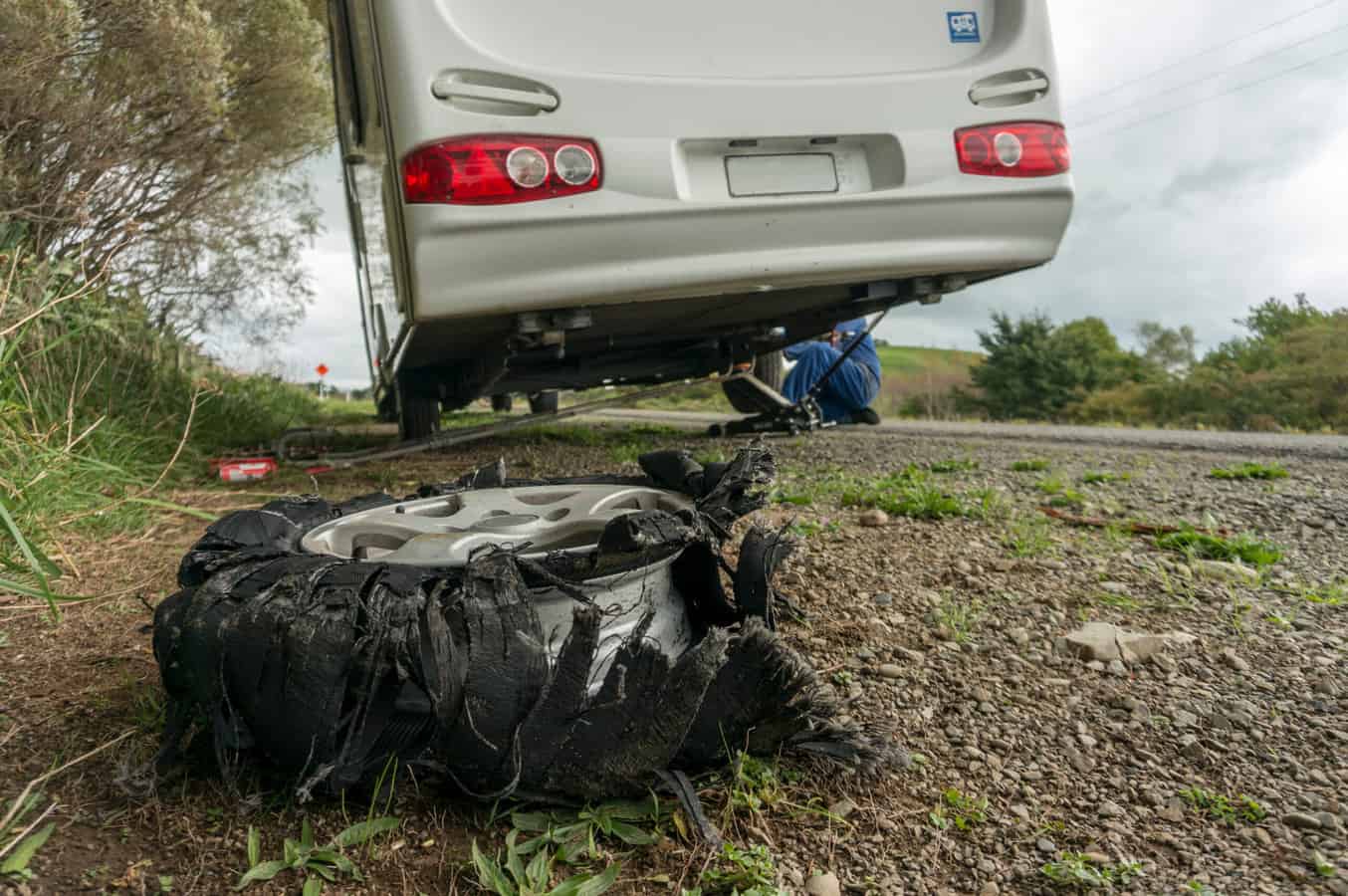
Need to know the best GPS for 37’ diesel
Pusher towing a vehicle.
Michelin has told me to check the tire pressure before I start out each day.
If you have used a Tire Pressure Monitoring System you know that as the time goes by the tire pressure goes up. This is do to heat being produced by the flexing tire mostly. Also 3 PM will be warmer than 8 AM. Furthermore I have seen that the tires getting the sun have higher temperatures and pressures.
Your article recommends checking the tire pressure during the day. You had better let your readers know that the pressures will be going up and that it is OK.
The author recommends removing tires while in storage; however, he neglects to tell us the practical aspects of achieving this. Presumably, we’re putting the whole chassis up on blocks where the entire weight of the vehicle is concentrated on four small pressure points. Is that wise? Do we not risk damaging the frame?
Another point to remember is to limit sharp corner turns where one or more tires on a tandem unit skid sideways.
Thanks for the article. I’ve always blocked up our campers for the winter when it was going to sit for a while to avoid having all the weight on one spot on the wheels and rotated them when we got ready to use the camper again. I did this just because it made since to me, when we bought a new 5th wheel, I asked the dealer and service people there about blocking and rotating tires, they had never heard of anyone doing that and that tires nowadays were made so much better that it wasn’t necessary. I still think it is a good idea and that removing them and storing them inside is even better. Was wondering about your thoughts on rotating tires, to me rotating the spares into the mix makes more sense than just keeping them as spares. What do you think?
I’ve always inflated my cold tires to the Maximum PSI written on the tire. Lately I’ve been inflating my tires 3 lbs less than Max when cold. As soon as I am driving 10 minutes the psi is at or past the maximum PSI. One I’m on the highway in the hot Florida sun my tire psi increases 10 to 20 lbs higher then the max tire psi.
What is the proper way to inflate your tires if you don’t have the ability to weigh.
The label on my RV says maximum PSI is 65lbs which was the same as my original tires. My new tires call for max 85 psi. Which psi is correct.
Thanks for your advise.
This article was very terse, non- specific, and Uber basic. As such it was much like commenting that one should lock their doors when leaving their RV and obey the speed limits while driving (i.e., not very useful).
Of all things that people talk about with respect to tires, the ONE THING that comes up most often in blogs/ web sites is “what tire pressure should one use”….and on this MOST IMPORTANT point the article is silent. It should have emphasized that one ONLY inflate the tires to exactly what is listed by the manufacturer (which is usually on a placard somewhere on the trailer or Motorhome), and to do the pressure check in the early morning or evening when the tires are cool an no Sunlight is on them.
Nothing was mentioned about bringing a portable compressor nor links provided on reviews of such compressors.
Similarly for TPMS units, no link to reviews was provided. I would have stressed the value of such units (takes away the guesswork, saves time in measuring all the tire pressures, can include Toads/trailers, etc.). This is particularly important as people tend to not do things that are hard/time consuming on long trips…like measuring tire pressure…and as such people tend to NOT do it as often as they should.
Tire safety didn’t mention where NOT to store tires (particularly around things that generate ozone) nor did it provide a link to reviews of the “best” UV protection products or recommendations from personal experience.
In all, there were SO many important/useful things left off I walked away from reading this article feeling like I just wasted my time.
I was told by a tire shop that the tires should be parked on wooden planks and never on cement, gravel or dirt. I remember my grandfather doing this for his car when it was going to be parked for a long period of time.
I am first year RV owner and yet to worry about storing it long period of time. However,
in regards to #3 safe Storage option, are you suggesting taking the 4 tires off and leaving the rig sit on Blocks? Prior to owning RV i used to own MC Trailers and when I did the same thing, I always lifted the wheels off ground and let trailer sit on 2-3Tons Jacks at every corner. I dont think this method would work efficiently for RV/ToyHaule much bigger and 4x heavier. How would you do it when you tore the wheels in your garage storage? Thanks for all the tips found them very helpful nonetheless.
Most of us can’t remove the tires from our RVs. This article missed the mark on how to care for tires while not on the road. Does parking on gravel harm the tires? How about concrete, asphalt, or wood?
Also after the DOT date is past 5 years your driving on old rubber. After 7 years you are asking for a blow out….that shiuld be #1 of 6 ways to protect your tires. Know when they are done.
we bought our 92 Diesal motorhome in 2013..it still had the 92 tires on it,seller had it sitting at his RV lot for 18 yrs with the tires all off the ground. he drove it here to Alberta in 2011 and it sat till i got it..i changed all 6 myself in back yard with a tire breaker bar and tire irons..added a bag of beads with new Chinese 14 ply tires that all my log truck owmer friends use.. and i gave all the 92 tires to a freind for his Farm truck.who still uses em today with no flats.these tires are now 9 yrs old with 2300 kms on them,i park it on 1 inch plywood and dont jack em off ground.
Great tire tips Kendall
Any suggestions for preventing mice in a fifth wheel?? We have a cedar creek with sealed under belly.
we are very conscious of not leaving food out. All food stand in Tupperware or rubber sealed containers. Vacuum regularly. I leave out bounce dryer sheets for smell. Some people told me about Irish Spring soap. We use steel wool in any potential hole openings around plumbing in the sink and in the bathroom area. My husband even created a funnel block that’s attached to our water hose so they can’t climb up the holes we are hooked up to water. Electrical plug attaches outside the RV so no issue here. Always have our screen door closed. Any other suggestions ? Thx
Suzanne
Moth balls in every closet and under seats and couch..no mice now in 9yrs,smells not so great in spring,,but who cares,,gather moth balls and put in ice cream pail for next fall.